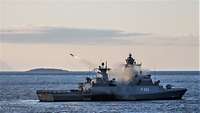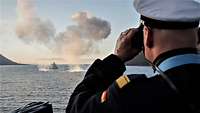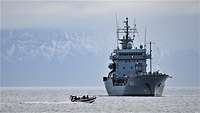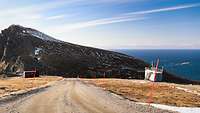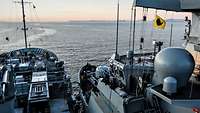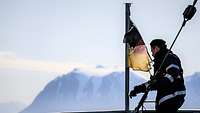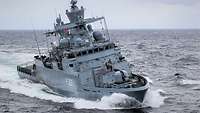Missile training: First RBS launch against land target
Missile training: First RBS launch against land target
- Date:
- Place:
- Rostock
- Reading time:
- 3 MIN
For the first time, the German Navy fired RBS15 Mk3 anti-ship missiles at a land-based target in Norway on 18 May.
The heavy guided missile has been in service with the German naval forces since 2008, together with its weapons platform, the Type 130 corvettes. During previous missile exercises, the vessels had so far only fired the RBS15 at targets at sea.
The corvette “Oldenburg” now provided proof that “the German Navy is now capable of using a precision stand-off weapon against targets relatively far behind the coast”, as the Test Director of Missile Firing Exercise 2022, Commander Nikolaus Hey, explains. “This step now also officially enables the corvettes to engage targets from sea in a wide land strip.”
Evidence of an expanded operational spectrum
The agile corvettes with their relatively shallow draught are more capable than any other ship of the German naval forces for such operations in the operational space of the coastal foreland, i.e. in shallow and confined waters. The “Oldenburg” demonstrated this during this exercise by sailing deep into the northern Norwegian fjords to fire her missiles from a well concealed position.
The RBS15 Mk3 belongs to the class of heavy naval missiles, defined by the comparatively large weight of its warhead. It can destroy targets on land such as fixed military infrastructure, but may also be used against mobile missile launchers – if their exact position is known. Target data is usually not provided by the corvettes’ own sensors, but comes from various third-party sources.
“The overall flight path required the missiles to follow different, decidedly challenging routes both over sea and over land,” Hey explains. The route made good use of the RBS15’s range of more than 200 kilometres, the missiles drastically altered course on their route while every now and then changing their flight altitude. This basically serves to hide the exact firing position, and thus the location of the corvette, from a possible opponent.
Passen Sie jetzt Ihre Datenschutzeinstellungen an, um dieses Video zu sehen
- copyright:
- © Bundeswehr
Comparable procedures as for sea targets
“The missile did exactly what it was supposed to do, what it was designed for,” says the Executive Officer of the “Oldenburg”, Lieutenant Till Niemann, expressing his satisfaction with the entire missile training. The strictly prescribed detailed procedure of firing was not new for the ship’s crew, as it was basically the same as for a target at sea.
Even though they did not train in a specific combat scenario, the crew had gone to battle stations for the firing. On the one hand, this serves the safety of the ship and crew in the event of an accident, and on the other hand, it allows the weapon system to be used realistically. For Niemann, the Missile Firing Exercise was thus a success. “We were able not only to train our crew and prove the performance of our corvettes,” he says, “but we also bring this experience into the 1 Corvette Squadron and thus the whole Navy.”
by German Navy Press and Information Centre (mmo) | e-mail


